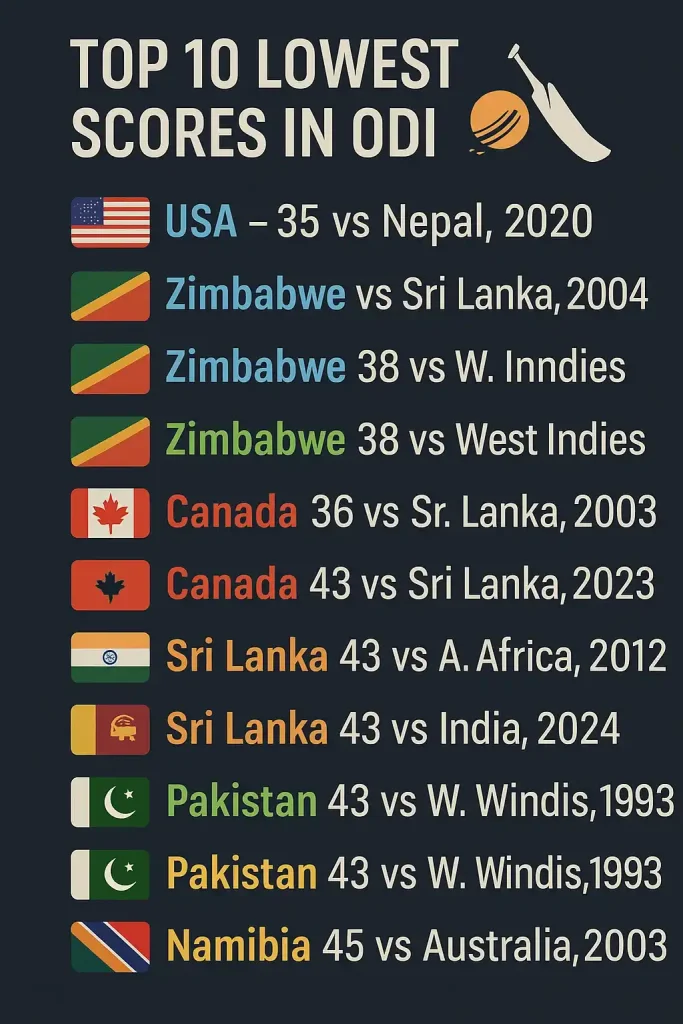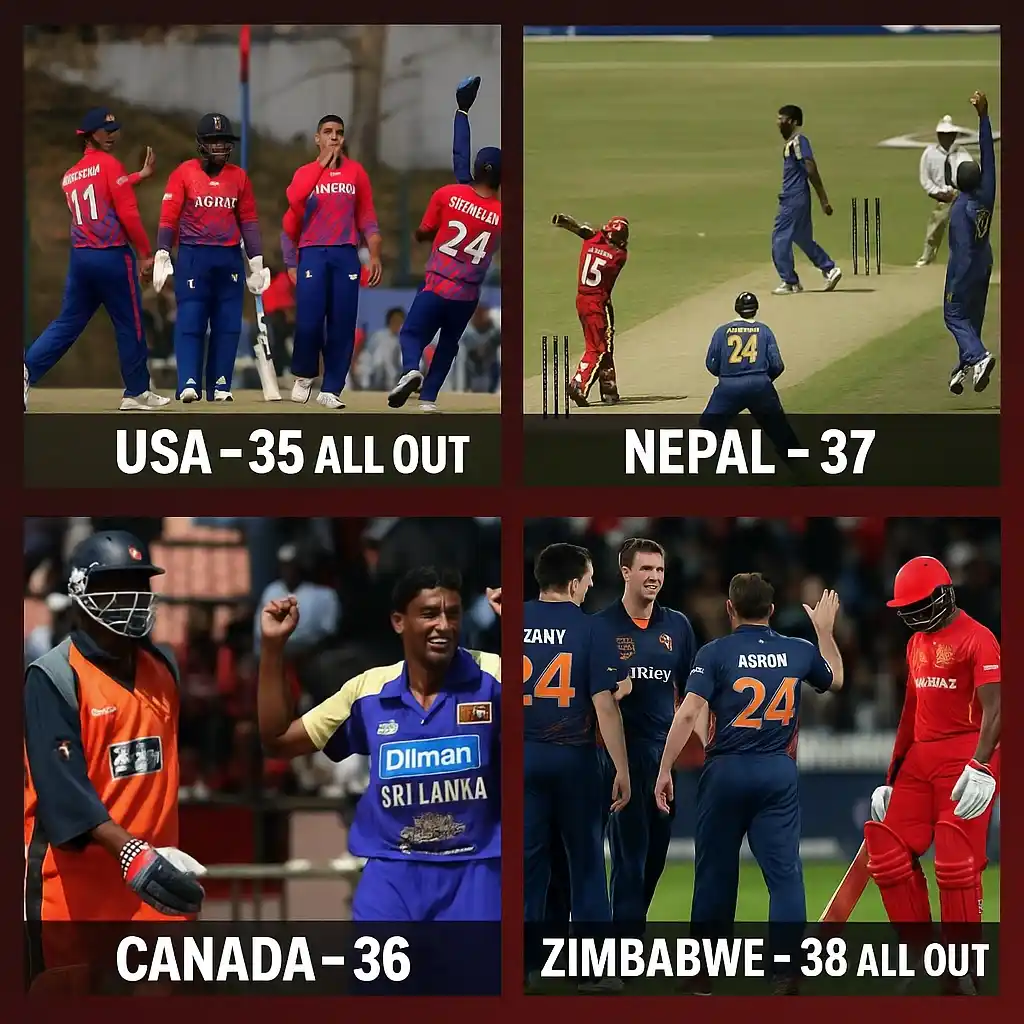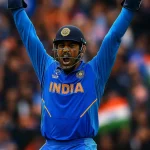
There’s nothing quite like the stunned silence that follows a batting collapse. One minute, you’re expecting a competitive game. The next, the entire team is back in the dressing room before the floodlights are fully on. For the players, it’s humiliation. For fans, it’s disbelief. But for the sport? These moments become legends. The lowest score in cricket history isn’t just about numbers. It’s about pressure, fear, and what happens when confidence walks out before the batter does.
ODI cricket, once considered the most balanced of the formats, has delivered some of the most jaw-dropping collapses in the game’s history. With 50 overs to bat, there should be time. But when panic sets in, 300 balls start to look like 30. That’s why the list of lowest team totals isn’t made up of minnows alone. Some big names have featured there too — a reminder that in cricket, no reputation is safe.
Table 1: 20 Lowest Team Scores in ODI Cricket (as of 2025)
| Rank | Team | Score | Overs | Opponent | Venue | Year |
| 1 | Zimbabwe | 35 | 18.0 | Sri Lanka | Harare | 2004 |
| 2 | Canada | 36 | 18.4 | Sri Lanka | Boland Park | 2003 |
| 3 | Zimbabwe | 38 | 15.4 | Sri Lanka | Colombo | 2001 |
| 4 | Sri Lanka | 43 | 20.1 | South Africa | Boland Park | 2012 |
| 5 | Pakistan | 43 | 19.5 | West Indies | Cape Town | 1993 |
| 6 | Namibia | 45 | 14.0 | Australia | Potchefstroom | 2003 |
| 7 | India | 54 | 26.3 | Sri Lanka | Sharjah | 2000 |
| 8 | Netherlands | 44 | 9.5 | Sri Lanka | Amstelveen | 2022 |
| 9 | USA | 65 | 22.0 | India | Lauderhill | 2024 |
| 10 | Bangladesh | 58 | 17.4 | India | Mirpur | 2014 |
The top of the table belongs to Zimbabwe and Canada, but that only tells part of the story. It’s Sri Lanka, with their blistering pace and vicious spin, who seem to feature more often as the destroyers. In fact, a glance at these numbers confirms what many already suspect: collapses have patterns. It’s usually early swing, combined with panic, followed by a lower-order implosion. That’s how teams go from 20/2 to 35 all out.
Why the Lowest Score in Cricket History Still Resonates
What makes these totals unforgettable isn’t just their rarity. It’s the context. Often, they happen on big stages. During World Cups. On home soil. Against arch-rivals. And almost always when a team walks in overconfident or undercooked. For example, Pakistan’s 43 against the West Indies in 1993 came when they were riding high. India’s 54 all out in Sharjah? That came during an era of domination.
The mental side of the game plays a huge role in these collapses. You get two early wickets, and suddenly, your footwork gets shaky. Dot balls pile up. The crowd gets quieter. Every run feels like a burden. And before you know it, you’re part of the lowest score in cricket history, immortalized in a stat no one wants attached to their name.
Table 2: Top Bowling Performances Behind ODI Collapses
| Bowler | Match Figures | Opponent | Venue | Year |
| Chaminda Vaas | 8-3-19-5 | Bangladesh | Pietermaritzburg | 2003 |
| Muthiah Muralitharan | 7.3-3-9-7 | India | Sharjah | 2000 |
| Glenn McGrath | 7-4-15-5 | Namibia | Potchefstroom | 2003 |
| Makhaya Ntini | 6-2-23-4 | Sri Lanka | Boland Park | 2012 |
| Mohammed Shami | 6-2-16-4 | USA | Lauderhill | 2024 |
These bowlers did not merely take advantage of helpful conditions; they commanded them. On a memorable day in 2003, Vaas removed the first three batsmen with his opening trio of deliveries-who could forget that hat trick? In Sharjah, Muralitharan transformed the pitch into one long, looping nightmare. McGrath later bent the ball as if it had an invisible string, consistently beating the best batsmen. Such feats are far more than numbers on a score sheet; they represent pure, unchallenged mastery and sit alongside every tale of low totals.

More Than Just Embarrassment
When a cricket team records history’s lowest total, chuckles erupt on fan forums and instant memes scatter faster than the scoreboard. Yet the players soon learn that embarrassment is only the warm-up act for a more brutal reality. Coaches pore over tactics, selectors replay footage for missing signs, and even bold drives are dissected one slow-motion frame at a time. The fallout rarely stays within the ground; an episode like this can nudge the whole culture sideways and leave its mark long after the final ball.
After India’s 54 at Lords in 2000, the squad hired mental coaches to face the cold dread of failure; Sri Lanka, stung by a 43, demanded every bowler master seam. Disgraceful digits thus morph into catalyst dots around which new ideas and attitudes circle. Paradoxically, as in life, crashing from a peak often feeds growth; sides that sail through don’t really check their guts, but the ones that nosedive learn urgency, sharpen will, and almost always head back hungrier.
Collapses Will Always Be Part of the Game
Every time batters invent a new swing and every time pitches seem to favour six-hitting over seam, spectators talk about the end of low scores. Clouds come, and the ground staff sprinkle the wicket; suddenly, the scoreboard looks the way it used to in black-and-white photographs. An opening duo that moves the ball a fraction away for a single over can launch everything into free-fall.
That is why 36 in Port-of-Spain still lives in conversation: it sits there quietly, even beside soaring totals of 480, reminding audiences who holds final authority. Bowling-first morning light, blisters of moisture underneath, and nerves-whittling pressure still govern results week in, week out. Curators refined the surface, coaches tweaked technique, but nothing shielded the great West Indies sides of the 1970s, and nothing shields modern megastars when one spell catches the edge and collapses the calm.
So when the news arrives of a team tumbling for 60 all out, try not to react with pure amusement. Study how the stumps are still jangling, how determination crumbled first, and how a bat first prized in velvet grip suddenly feels oversized. That sight is more than failure captured on film; it is cricket stripping assumptions, underscoring that even the most talented players can always flirt with disaster. Egos learn quickly. Pressment turns into history.

Meet Arjun Kushaan, a passionate cricket analyst at The Cricket24x7. From street matches in his childhood to competitive college tournaments, cricket has always been a central part of Arjun’s life. With a strong background in data analysis and a natural affinity for numbers, he brings a fresh, analytical lens to the game. At The Cricket24x7, Arjun blends his deep love for cricket with his data-driven approach to deliver detailed insights and well-rounded coverage for fans of the sport.






